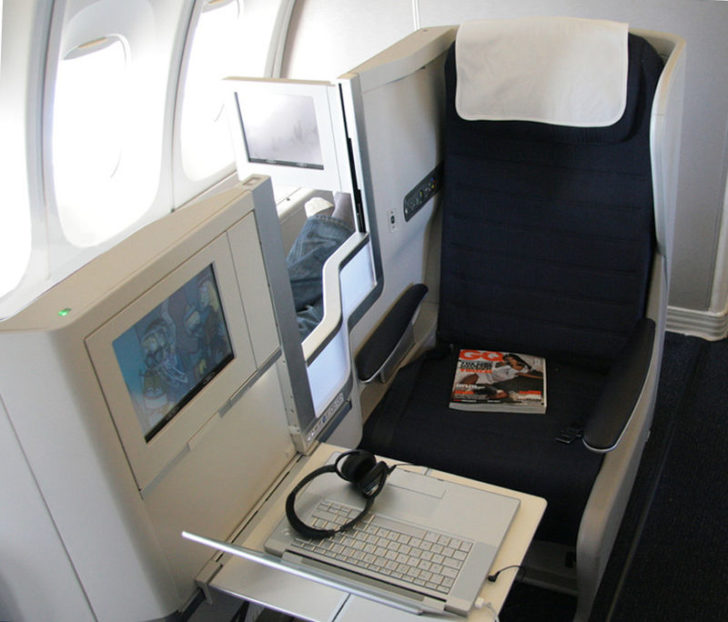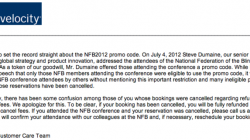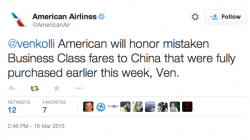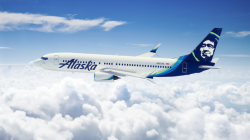One seeming truth about this hobby is that if a deal is truly amazing, it will not last. You have to act fast, drop whatever you’re doing to get in on a mistake fare or ridiculous fare sale as soon as your hear about it.
For instance, there was a fare sale on business class this week (launched by BA/AA, matched by many star alliance carriers) for $1460-$1600 roundtrip from the West Coast to several cities in Europe in business class. It’s a slow time of the year for business travel, so the folks at BA likely were trying to stir demand. There happened to be a string of other promotions that stacked on this fare, making it a fantastic deal, clocking in at around $315-350 roundtrip in business class on AA or BA. I booked for myself and my boyfriend to go to Barcelona for New Years on AA’s new 321T, 767 and 777-300ER business class, since it was cheaper than going ANYWHERE beachy in North America (I know BCN won’t be beachy, but we’re both foodies and BCN and San Sebastian seems like a great way to eat our way into the new year).
When a fare deal breaks, whether via The Flight Deal, Flyertalk or Gary’s blog, you have mere minutes to hours to get something ticketed or you won’t be flying. And nothing counts until you have a ticket number (not a PNR/Record Locator!)
Determine if the Deal Is Actually Useful
My first mistake fare was an Etihad business class fare from the Seychelles to Abu Dhabi to Dublin for $300. A fantastic deal, but positioning to the Seychelles is no small feat, involving transits in Zurich, London and Addis Ababa (on the Ethiopian 787). Thankfully, I was planning on taking a long, round the world trip, so this fit into my plans well, as I had never been to any of those places.
But there are plenty of other fares, ex-Yangon, Colombo, Cairo, Casablanca that are equally just as hard to position to from the US. So despite all the frenzy and potential savings, take a step back and make sure it’s even worth spending time on. Remember it will be an hour or two of hunting and pecking.
Use the Airline’s 24-hour Refund/Hold to Your Advantage
In these situations, time is of the essence. So I generally try to book SOMETHING that will work before I try to optimize the routing for particular products or routings. You can always cancel if you find something better, but it keeps your preferences loose enough to get something on the books that works.
This should make you more flexible/risk-seeking than typical travel. For instance, I live in San Francisco. So booking any ticket originating from LAX or Seattle is also an option because fares are routinely $65-80 to position to the correct airport. All else being equal, if I can’t get a fare to price from SFO, I’ll book out of LA and worry about getting there later.
Almost every mainline carrier (and many low cost carriers) will allow you to cancel a ticket free of charge within 24 hours of booking it. Use that to your advantage!
Determine if This Is a Mistake Fare or Just a Good Deal
The third thing you should figure out is whether the deal is a mistake (someone forgot a zero when filing the fare or priced it in the wrong currency) or simply a really good sale.
If it’s a mistake, you should only book tickets that have extra precautions and have more of a paper trail.
One way to do this is by ensuring the itinerary touches US soil. No ditching in Canada or repositioning to a Caribbean island. By having your itinerary originate, connect or terminate in the US, you can invoke the DOT’s fair pricing consumer protections, which requires airlines to honor fares that they quote you (and you pay) without the ability to raise them on you later. Some airlines abide by this, others don’t (and the ironclad language of the regulation has been cracking – since airlines have successfully argued that mistakes may be exempt if they are handled quickly).
I also screenshot every screen while booking just to have an extra paper trail.(Shift+Command+4 will give you crosshairs to select a region and immediately save it to your desktop on a mac) If it is a mistake, the airline will be happy to have you cancel your itinerary at any point before departure.
If it’s a really good deal, tell your friends! It’s likely that the deal will last as long as there are tickets, so it’ll gradually be harder to find the low fares as they get booked up.
Consider Flying Immediately if It’s a Mistake Fare
In many cases, a mistake is yanked as soon as it’s caught by a person with enough IT chops to pull the plug. So many people book an itinerary departing in a few hours for a far-flung boondoggle to Australia, the Seychelles or Myanmar. Typically, it will take an airline a day or two to convene the right decision-makers to determine whether they will (or have to) honor a mistake fare, so you’re protected if you can somehow take the time off work (maybe you’re a student or self-employed).
If Traveling with Others, Book for Them First and Ask Later
It can often be more complicated to book mistake fares when significant others or friends are not staring at the screen with you. So it may make sense to get their details (full name, birthdate, passport number and expiration) in advance and simply book a ticket for them when the deal hits. You can always call the airline within 24 hours to cancel, and with mistake fares, the airline will be happy to give you a refund whenever. Most friends and family, especially if you pick a difficult/expensive time to find travel (summer or the holidays) will be able to shift their schedule by a day or two to enjoy $300 round trip business class to a sunny beach destination in January 🙂
Optimize the Itinerary
Now that you have a ticket (or two or three) that work for you and your companions, you can optimize! With tickets on the books, start looking for itineraries that still fall under the mistake or sale restrictions, but are “better” than what you booked.
Want to hit up more airports? Read the routing rules (pull them from ITA or Expertflyer) and understand what is still possible, what dates the fare is valid. Mistake fares are a great way to rack up a ton of miles or get status easily (really it’s the only kind of mileage running that makes sense anymore – particularly if it’s in business or first). Want to fly a fancier partner? Keep an informal hierarchy of carrier quality in the back of your mind (or check one out here)
I often optimize for nicer planes, and I like 23 hour layovers, so taking a look at the equipment flying on each route and the schedule can help you get a nicer and nicer experience while you still get the insanely cheap deal (though it’s fun to watch the status junkies make tradeoffs of “Well it’s $63 more, but I get an additional 2456 miles..”)
Finally, Garden These Reservations; Watch Them Like a Hawk!
Finally, remember to watch these reservations closely! You’re not done once they’ve ticketed! Airlines make schedule changes all the time and I’ve seen individual segments be cancelled out of an itinerary because a partner carrier doesn’t want to cooperate. In those cases, call the airline you booked with and see if they’ll accommodate you on one of their own flights.






